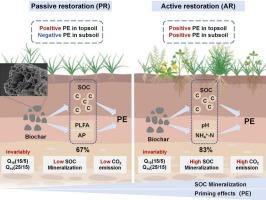十年主动恢复对沙化草地土壤有机碳的正启动效应:生物炭的放大效应
IF 7
2区 环境科学与生态学
Q1 ENVIRONMENTAL SCIENCES
引用次数: 0
摘要
草地恢复可以通过主动和被动两种方法来实现。生物炭改善了土壤结构和养分有效性,因此在退化草地的恢复中起着至关重要的作用。然而,添加生物炭对沙漠化草地主动和被动恢复的长期影响尚不清楚。本研究的目的是通过确定生物炭如何影响有机碳矿化和在经历十多年主动或被动恢复的草原上的启动效应来填补这一空白。结果表明:与退化草地相比,主动恢复下施用生物炭显著增加了土壤CO2排放量;表层土壤(120.5 ~ 297.0%)和底土(157.2 ~ 287.3%)均存在正启动效应。相反,在被动恢复条件下,表层土壤的启动效应为正(34.7% ~ 80.9%),底层土壤的启动效应为负(- 67.1% ~ - 47.7%)。在被动恢复中,磷脂脂肪酸(PLFA)是启动效应的主要驱动因素,而在主动恢复中,土壤pH是启动效应的主要驱动因素。本研究通过评价生物炭对退化草地有机碳矿化和启动效应的影响,将恢复和土壤生态学领域联系起来。这些发现强调了了解不同的恢复方法如何与生物炭添加相互作用以影响土壤矿化过程的重要性。该研究为草原管理者和决策者制定有效的恢复策略提供了有价值的见解,特别是在气候变化的背景下。本文章由计算机程序翻译,如有差异,请以英文原文为准。

Decade-long active restoration induced positive priming effects on soil organic carbon in desertified grassland: The amplifying effect of biochar
Grassland restoration can be achieved through active or passive methods. Biochar enhances soil structure and nutrient availability and, therefore, can play a crucial role in restoring degraded grassland. However, the long-term effects of biochar addition on both active and passive restoration of desertified grasslands remain unclear. This aim of this study was to fill this gap by determining how biochar influences organic carbon mineralization and priming effects in grasslands undergoing more than a decade of active or passive restoration. The results demonstrated that, compared to degraded grassland, biochar application under active restoration increased soil CO2 emissions significantly. Positive priming effects were observed in both the topsoil (120.5–297.0 %) and subsoil (157.2–287.3 %). Conversely, under passive restoration, priming effects were positive in the topsoil (34.7–80.9 %) but negative in the subsoil (−67.1% to −47.7 %). In passive restoration, phospholipid fatty acids (PLFA) were the primary drivers of priming effects, while in active restoration, soil pH was the primary driver. This study bridges the fields of restoration and soil ecology by evaluating the effects of biochar on organic carbon mineralization and priming effects in degraded grasslands. The findings highlight the importance of understanding how different restoration approaches interact with biochar addition to influence soil mineralization processes. This research provides valuable insights for grassland managers and policymakers in developing effective restoration strategies, particularly in the context of climate change.
求助全文
通过发布文献求助,成功后即可免费获取论文全文。
去求助
来源期刊

Ecological Indicators
环境科学-环境科学
CiteScore
11.80
自引率
8.70%
发文量
1163
审稿时长
78 days
期刊介绍:
The ultimate aim of Ecological Indicators is to integrate the monitoring and assessment of ecological and environmental indicators with management practices. The journal provides a forum for the discussion of the applied scientific development and review of traditional indicator approaches as well as for theoretical, modelling and quantitative applications such as index development. Research into the following areas will be published.
• All aspects of ecological and environmental indicators and indices.
• New indicators, and new approaches and methods for indicator development, testing and use.
• Development and modelling of indices, e.g. application of indicator suites across multiple scales and resources.
• Analysis and research of resource, system- and scale-specific indicators.
• Methods for integration of social and other valuation metrics for the production of scientifically rigorous and politically-relevant assessments using indicator-based monitoring and assessment programs.
• How research indicators can be transformed into direct application for management purposes.
• Broader assessment objectives and methods, e.g. biodiversity, biological integrity, and sustainability, through the use of indicators.
• Resource-specific indicators such as landscape, agroecosystems, forests, wetlands, etc.
 求助内容:
求助内容: 应助结果提醒方式:
应助结果提醒方式:


